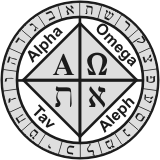
And the seventh angel sounded; and there were great voices in heaven, saying,
The kingdoms of this world are become the kingdoms of our Lord,
and of his Christ; and
he shall reign for ever and ever. And the four and twenty elders, which sat before God on
their seats, fell upon their faces, and worshipped God, Saying, We give thee thanks, O Lord God
Almighty, which art, and wast, and art to come; because thou hast taken to thee thy great power,
and hast reigned. Revelation 11:15ff (Spoke 22, Cycle 3)
The Consummation of God's Plan of the Ages marked
by the trumpet of the seventh angel exemplifies yet again the consistent
symbolic application of the Number Seven throughout the Bible,
from Genesis to Revelation. The Consummation is characterized by the transformation of the "kingdoms of this world"
into the "kingdoms of our Lord, and of his Christ," thus fulfilling the Lord's prayer,
"Thy Kingdom come, thy will be done on earth as it is in heaven" (Matthew 6:10).
The theme of the Kingdom of God
is the key to the symmetric history that flows from Abraham to Christ and from Christ to the
present age. It is symmetrically centered on the incarnation of Jesus Christ,
the Eternal Lord and King of
Kings who identified Himself as the Lord God Almighty via the Greek Alpha Omega
(   )
which corresponds to the Hebrew Aleph Tav
( )
which corresponds to the Hebrew Aleph Tav
(   ). These symbols
unite to form the
Capstone Signature ). These symbols
unite to form the
Capstone Signature    that seals God's Word from beginning to end. The overwhelming miracle of God is that
exactly the same alphabetic pattern
serving as a template of the large-scale symmetric structure of His Word also serves as a template for
a symmetric pattern that spans forty-three hundred years of Judeo-Christian history.
In the diagram below, each century corresponds to a single
Hebrew letter, except for the
First Century AD in which
the Tav consummating the BC Cycle coincides with the
Aleph initiating the AD Cycle. It is this union of Aleph and Tav,
this complete interpenetration of the beginning with the end,
that yields the Key to the symmetric structure of Judeo-Christian History.
that seals God's Word from beginning to end. The overwhelming miracle of God is that
exactly the same alphabetic pattern
serving as a template of the large-scale symmetric structure of His Word also serves as a template for
a symmetric pattern that spans forty-three hundred years of Judeo-Christian history.
In the diagram below, each century corresponds to a single
Hebrew letter, except for the
First Century AD in which
the Tav consummating the BC Cycle coincides with the
Aleph initiating the AD Cycle. It is this union of Aleph and Tav,
this complete interpenetration of the beginning with the end,
that yields the Key to the symmetric structure of Judeo-Christian History.
The Key to the Kingdoms

The diagram above displays the
two great interlinked cycles of history. The first cycle (on the bottom) represents the time from Abraham
to Christ. It begins with Aleph in the 21st Century BC with the call of Abraham
(Aleph KeyWord Avraham) and
ends with Tav in the First Century AD when Christ was crucified, the Temple was destroyed, and the Jewish Age was
consummated. The second cycle (on the top) begins with
Aleph in the First Century with the incarnation of God
(Aleph KeyWord Elohim) in Christ and the Birth of His Church
at Pentecost. To see how the Aleph of the AD cycle overlaps the Tav of the
BC cycle in the First Century AD we need to take a side-view
of the diagram which is actually a three-dimensional spiral centered on the incarnation of the
Lord Jesus Christ:

The events of the 21st Century BC (Aleph) prophetically
anticipated the Cross (Tav) of Jesus Christ when Abraham the Father of the Faith (Aleph KeyWords
Abraham, Av and Emunah)
sacrificed his only beloved son Isaac.
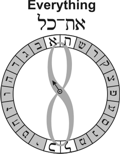 The union of Aleph Tav at the center of Christian History
transforms the universally recognized
metaphorical understanding of the Advent of Christ and His Work on the Cross as
the "center of time" into a
literal description [see From Eternity to Eternity].
The diagram satisfies the definition of a
complete macrohistory The union of Aleph Tav at the center of Christian History
transforms the universally recognized
metaphorical understanding of the Advent of Christ and His Work on the Cross as
the "center of time" into a
literal description [see From Eternity to Eternity].
The diagram satisfies the definition of a
complete macrohistory  that must have "linear, cyclical, and transcendental dimensions." The sequence of centuries defines
the linear dimension, the pattern of the Bible Wheel defines the cyclical dimension, and the unifying
function of the Aleph Tav defines the transcendental dimension. This is particularly significant when
it is recalled that the word et-kol which means "everything" (Gen 1:31) is spelt out when the same
"figure 8" symmetry is applied to the Alphabetic Wheel.
The "Key to the Kingdoms" diagram is also highly reminiscent of
Oscar Cullmann's
"shape of history" discussed by Charles D. Barrett in his
Understanding the Christian Faith
that must have "linear, cyclical, and transcendental dimensions." The sequence of centuries defines
the linear dimension, the pattern of the Bible Wheel defines the cyclical dimension, and the unifying
function of the Aleph Tav defines the transcendental dimension. This is particularly significant when
it is recalled that the word et-kol which means "everything" (Gen 1:31) is spelt out when the same
"figure 8" symmetry is applied to the Alphabetic Wheel.
The "Key to the Kingdoms" diagram is also highly reminiscent of
Oscar Cullmann's
"shape of history" discussed by Charles D. Barrett in his
Understanding the Christian Faith  .
Here is a scan from page 67 of his book: .
Here is a scan from page 67 of his book:

As an aside, this is a wonderful example of the providential guidance of our Lord. I found
Barrett's book at a yardsale about a week after drawing the diagram of the Key to the Kingdoms!
He supplies everything we need to accomplish His work just at the time we need it.
The "chance" discovery of Cullman's diagram in Barrett's book introduced me to
the extraordinarily rich, broad, and deep study called the Philosophy of History.
Once again, the Bible Wheel has proven its abundant fruitfulness.
The idea that history has a large-scale "shape" is
very old. Most pagan systems see history as
completely cyclical with no beginning, no end, and no progress. Just endless repetition like that expressed in
Ecclessiastes 1:9 "there is no new thing under the sun"
[see Spoke 21 > Where is the Sun?].
This view was strongly opposed by Augsustine in
the fifth century who correctly saw it as the antithesis of the Christian revelation of progress from
Genesis through to the final judgment and consummation in Revelation.
But Christian historians could
never fully shake the cyclical idea because it is obviously manifest in the fulfillment of types and shadows
where we have a
formal cyclical repetition like a spiral rather than a closed circle that never advances. The shape of a
spiral unites the progression of the linear sequence with the cyclical repetitions. The same pattern of
a spiral that returns to the beginning on a higher level has often been used to describe the large-scale
pattern of Scripture, (e.g Revelation returns us to the Garden from which we were exiled in Genesis, see
From Eternity to Eternity).
Frank E. Manuel
gives an excellent review of these ideas in his
Shapes of Philosophical History  . .
Jesus came into Galilee, preaching the gospel of the kingdom of God, And saying,
The time is fulfilled, and the kingdom of God is at hand:
repent ye, and believe the gospel. Mark 1:14f
But if I cast out devils by the Spirit of God, then the kingdom of God IS COME unto you.
Matthew 12:28

Aleph-Tav at the
Center of History |
The
Key to the Kingdoms is centered on the inauguration of the Kingdom of God at
incarnation of the Lord Jesus Christ. The incarnation of the Alpha Omega corresponds to the
Aleph Tav representing the First Century AD at
the center of time in Judeo-Christian history. The appearance of Christ at
the exact midpoint of the "Key to the Kingdoms" is perhaps the most astounding feature of the diagram.
It corresponds precisely to the theological insights of many biblical scholars such as those of
Oscar Cullman (discussed above) which Anthony Hoekema
brought together in his excellent book
The Bible and the Future  . The
entire book, which includes the numbered footnotes, can be read online. Here is an extended excerpt from
Chapter 3, Section 3 called "Christ is the Center of History" in which he repeatedly refers to the incarnation
as the inauguration of the Kingdom of God at the midpoint of history (emphasis added): . The
entire book, which includes the numbered footnotes, can be read online. Here is an extended excerpt from
Chapter 3, Section 3 called "Christ is the Center of History" in which he repeatedly refers to the incarnation
as the inauguration of the Kingdom of God at the midpoint of history (emphasis added):
| "The exclusively historical character and dynamism of Christianity are the result of
the Coming of Christ, which constitutes the central fact of Christian history. This fact is
unique and non-recurring — the essential quality of everything historical. And it focuses the
whole of world history."9 These words by the Russian writer, Nicolas Berdyaev,
will serve to introduce us to another major feature of the Christian interpretation of history:
that Christ is the center of history. Oscar Cullmann has called our attention to the fact that
the very way we date our calendars, numbering years forward or backward from the birth of Christ,
has theological implications:
... The theologically decisive and interesting point is not the fact that goes
back to Dionysius Exiguus, that the birth of Christ was taken as the starting point of
subsequent enumeration. ... The decisive thing is rather the practice, which has been in vogue
only for the last two centuries, of numbering both forward and backward
from the birth of Christ.
Only when this is done is the Christ-event regarded as the temporal mid-point of
the entire historical process.
We say "Christian system of reckoning time." But it is the common system in the Western world. . . .
Yet today scarcely anyone thinks of the fact that this division is not merely a convention resting upon
Christian tradition, but actually presupposes fundamental assertions of New Testament theology concerning
time and history.10
Cullmann goes on to say that the primary difference between the Old Testament understanding of history
and that of the New Testament is that the midpoint of history has moved from
the future to the past. For the New Testament believer the coming of Christ is that midpoint,
and he is therefore conscious of living between the midpoint of history and its culmination
— the Parousia of Jesus Christ.11
This implies that the coming of Christ was the single most important event of human
history. It also implies that this event had decisive significance for all subsequent and even for
all preceding history. Cullmann's D-day and V-day analogy has already been mentioned:
The first coming of Christ was like D-day, in that it was the decisive battle of the war, guaranteeing
the enemy's final defeat. The second coming of Christ will be like V-day, in which the enemy finally
lays down its arms and surrenders.12
The New Testament believer lives, as it were, between D-day and V-day.13
The fact that the coming of Christ is the midpoint of history means that in this central
event "not only is all that goes before fulfilled but also all that is future is decided."14
The Christ-event, therefore, puts its distinctive stamp on all of history.
... Since the kingdom of God was fulfilled in Christ, then none other than
that same kingdom can come at the end of history... . This action [the fulfillment of Old Testament
promises in the coming of Christ]
fulfills both what has gone before and what follows after it in history and constitutes ontologically the imposition of
the divine pattern of providence and redemption upon history, and epistemologically the point at which
the revelation of the divine will and purpose is fully revealed. It also means that the end of
historical process can be none other than the final manifestation or revelation of the fulfillment
of history that took place at its 'centre'.15
The Bible, therefore, teaches us to see human history as completely dominated by Jesus Christ.
|
"The final manifestation or revelation of the fulfillment
of history that took place at its 'centre'" is the key to understanding the whole eschatological
message of Scripture, and the real meaning of the Work of Christ on the Cross when He bore the
Divine Judgment we were destined to receive at the End of Time when God will judge the world. This is what I mean when
I say that "time and eternity met in the Cross." Indeed, the "meeting of opposites"
are characteristic of the Cross,
most notably the meeting of perfect Justice and immeasurable Grace in the suffering of our great
God Who became Man in Jesus Christ!
"O the depth of the riches both of the wisdom and knowledge of God! how unsearchable are his judgments,
and his ways past finding out!" (Rom 11:33)
William Barclay provides another powerful and lucid explanation of the same ideas
in the second chapter of his
Many Witnesses, One Lord  (also available online): (also available online):
|
In the Synoptic Gospels the Kingdom is conceived of in a double way.
It is conceived of as a growth. It is a slow, steady, unseen growth, developing not
by the effort of man, but by the power of God (Mark 4.26-29; Matthew 13.33).
In this sense the Kingdom might well be called the product of the power and Spirit of God
at work in the world and in the minds and hearts of men. But it is also conceived of as
a consummation (Matthew 24; Mark 13). It is not, as it were,
a growth which will never be anything else but a growth; it is a growth moving towards a
consummation in which at last the will of God will be done not partially but completely,
and in which the kingdoms of the world will become the Kingdom of God. Quite inevitably
that involves judgment, for where there must be obedience there can be disobedience, and where
there is a king who lays claim to the world there must be rebels who refuse his claim.
Wherein then is Jesus' place within this Kingdom? First and foremost, Jesus is the Kingdom, Jesus embodied the Kingdom.
If the Kingdom is a state and condition of things in which the will of God is perfectly accepted and done,
then Jesus is the only person in the universe who perfectly accepted that will. The thread that binds
the life of Jesus together is his continual acceptance of the will of God. At the beginning and
the end of his life on earth we see him accepting that will. In the temptation story (Matthew 4:1-I I;
Luke 4.1-13) we see him accepting that way which can end only in the Cross.
In Gethsemane (Matthew 26.36-46; Mark 14.32-42; Luke 22.39-46) we see him still accepting this will.
In Jesus the Kingdom actually and in fact did come. To look at him is to see life in
the Kingdom.
|
The idea of the Kingdom of God as something growing
from a seed comes directly from the parables taught by the Lord Jesus Christ:
- And he said, So is the kingdom of God, as if a man should cast seed
into the ground; And should
sleep, and rise night and day, and the seed should spring and grow up, he knoweth not how.
For the earth bringeth forth fruit of herself; first the blade, then the ear, after that
the full corn in the ear. But when the fruit is brought forth, immediately he putteth in the
sickle, because the harvest is come. Mark 4:26ff
- Another parable put he forth unto them, saying, The kingdom of heaven is likened unto
a man which sowed good seed in his field: But while men slept, his enemy came and
sowed tares among the wheat, and went his way. But when the blade was sprung up, and brought forth
fruit, then appeared the tares also. So the servants of the householder came and said unto him,
Sir, didst not thou sow good seed in thy field? from whence then hath it tares? He said unto them,
An enemy hath done this. The servants said unto him, Wilt thou then that we go and gather them
up? But he said, Nay; lest while ye gather up the tares, ye root up also the wheat with them. Let
both grow together until the harvest: and in the time of harvest I will say to the reapers,
Gather ye together first the tares, and bind them in bundles to burn them: but gather the
wheat into my barn. Matthew 13:24ff
- Another parable put he forth unto them, saying, The kingdom of heaven is like to a
grain of mustard seed, which a man took, and sowed in his field: Which indeed is the least of
all seeds: but when it is grown, it is the greatest among herbs, and becometh a tree,
so that the birds of the air come and lodge in the branches thereof.Matthew 13:31ff
The growth pattern from the "kingdoms of this world" to the Kingdom of God
expands on the alphabetic integration of the history of David's Kingdom
that I discovered some years ago when I noticed many
strong and obvious correlations between the Spokes of
the Wheel and the centuries after Christ. It is to this great miracle we now turn ...
Jesus answered, My kingdom is not of this world: if my kingdom were
of this world, then would my servants fight, that I should not be delivered to the Jews: but now is my
kingdom not from hence. John 18:36
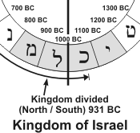 The diagram is called "The Key to the Kingdoms" because it
displays the symmetric relation between the three great kingdoms of Judeo-Christian history.
Two of the kingdoms are the earthly "kingdoms of this world" that appear symmetrically at the
top and bottom extremities of the diagram.
The third kingdom is the Kingdom of God that was inaugurated at the
incarnation of the Lord Jesus Christ. It is represented by the Aleph Tav at the center of the diagram. The diagram is called "The Key to the Kingdoms" because it
displays the symmetric relation between the three great kingdoms of Judeo-Christian history.
Two of the kingdoms are the earthly "kingdoms of this world" that appear symmetrically at the
top and bottom extremities of the diagram.
The third kingdom is the Kingdom of God that was inaugurated at the
incarnation of the Lord Jesus Christ. It is represented by the Aleph Tav at the center of the diagram.
The two earthly kingdoms consist of 1) the
Kingdom of Israel founded about 1050 BC and divided between North and South
about 931 BC, and 2) the Kingdom of the
Church - the Christian Theocracy (Holy Roman Empire) -
founded with the crowning of Charlemagne
in 800 AD and divided between East and West in 1054 AD
(Great Schism). The record of these two kingdoms displays an astounding
depth of symmetry. The two time periods span opposite vertical extremes of the diagram with a bias towards
the left in both cases.
Furthermore, the geography of the divisions is symmetric
(North/South versus East/West) as
well as the time of the divisions which in both cases occurred near the center of
the centuries
adjacent to the vertical line of bilateral symmetry that divides the entire diagram itself!
The diagram therefore is symmetric both in space and time and centered on
the incarnation of the Lord Jesus Christ.
Yet this is
but the beginning of wonders ....
 The true miracle of the
Key to the Kingdoms is seen in the supernatural integration of three fundamentally independent
sequences:
1) the order and meaning of the letters of the Hebrew Alphabet, 2) the order and content of
the Books of the Bible, and 3) the rise of the two earthly kingdoms in Judeo-Christian History.
The four middle letters at the exact center of the alphabetic
sequence, which correspond to the time periods of the two kingdoms, spell the word
malki, meaning "my king" or "king of" depending on vowel points. It is extremely important
to take this in: the meaning of the Hebrew letters and the word they spell coheres with the
historical events in the corresponding centuries! The true miracle of the
Key to the Kingdoms is seen in the supernatural integration of three fundamentally independent
sequences:
1) the order and meaning of the letters of the Hebrew Alphabet, 2) the order and content of
the Books of the Bible, and 3) the rise of the two earthly kingdoms in Judeo-Christian History.
The four middle letters at the exact center of the alphabetic
sequence, which correspond to the time periods of the two kingdoms, spell the word
malki, meaning "my king" or "king of" depending on vowel points. It is extremely important
to take this in: the meaning of the Hebrew letters and the word they spell coheres with the
historical events in the corresponding centuries!
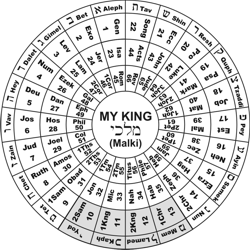 |
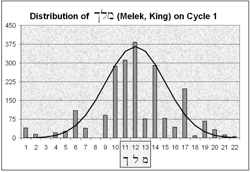 |
These four middle letters span
the four books of 2 Samuel, 1 & 2 Kings, and 1 Chronicles on the first Cycle of the Bible Wheel (highlighted gray).
These books begin with the reign of King David (2 Samuel),
the reign of his son Solomon, the division of the kingdom, and the reign of all the other kings of
Judah and Israel (1 & 2 Kings). The Book of 1 Chronicles then reiterates the reign of David, ending
with his death. God explicitly reiterated this pattern in the alphabetically
structured Psalm 145, which He designed so that
the word "kingdom" appears only in the verses corresponding to the 11th, 12th, and
13th letters which spell melek (king)!
Furthermore, the actual distribution of the word melek (king)
on Cycle 1 is centered on the central letters which spell the word melek itself!
The graph shows how the distribution closely follows a bell curve centered on the Twelfth Letter
Lamed in the center of the word melek (king),
which means that the Hebrew Alphabet describes the actual content of the books themselves!
In other words, the structure of the Bible Wheel describes its own content! God designed it to be self-descriptive and
therefore self-confirming!
Furthermore, the symbolic meanings of these "middle letters" and their relation to the
idea of the Kingdom has
been well understood in Rabbinic tradition since the time of the Talmud
[see Spoke 12 > Christ our Master and Teacher].
And now we can begin to understand the depth of the miracle displayed here.
We have a threefold integration of 1) The order and meanings of the Twenty-two Hebrew letters (as
taught by God in Scripture and witnessed in the ancient rabbinic tradition),
2) the order and content of the Books of the Bible, and 3) the actual historical rise of the Kindom of Israel!
This is what is so amazing about the diagram. Exactly the
same correlation of the Hebrew Alphabet, the Holy Bible, and Christian History continues
into the centuries after Christ where we see the rise of the Christian Theocracy in the
middle ages also corresponds to the middle letters of the Hebrew
Alphabet, just like the period of the Hebrew Theocracy! We have a completely symmetric integration of the
two earthly kingdoms at the top and bottom
extremeties of the diagram with the sequence and meanings of the Hebrew letters! Yet there is still more ...
the two short periods of Jewish independence are also symmetrically integrated with both the sequence and the
meanings of the letters, as we shall presently see ...
And Moses chose able men out of all Israel, and made them heads (roshim)
over the people,
rulers (sarim) of thousands, rulers of hundreds, rulers of fifties,
and rulers of tens.
Exodus 18:25
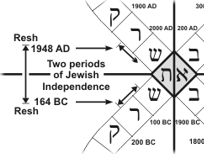
The primary test of a good "scientific model" is if it leads to new, unexpected, and fruitful
insights. It is especially impressive when the new insight is independent of the considerations that
motivated the development of the model. This is what has been so exciting about studying the Wheel over all these years.
It has proven itself to be a most excellent and abundantly fruitful "model" of the Bible [for example, see the
Derivation of the Sevenfold Canon from First Principles]. This happened to me again immediately
after drawing the diagram of the Key to the Kingdoms. It was motivated by the success I had in tracing
out the correlation of the primary events in
the centuries after Christ with the Hebrew alphabet, especially in light of the correlation of
of both Kingdom ages discussed above. I had no idea that it would also reveal an
extremely obvious geometric, thematic, and alphabetic correlation based on a feature of Hebrew history that has occured only
twice since the Babylonian Exile.

The name of the
Twentieth Letter - Resh - is based on rosh which literally
denotes the head and figuratively denotes a beginning, a leader, or a
ruler [Spoke 20 > Beginning of Wisdom].
This is how it is used
in Exodus 18:25 (quoted above) when Moses chose "able men" to be heads (roshim) and rulers (sarim) over the people. The
two words - rosh (head) and sar (ruler) - have similar meaning and are near anagrams of each other, differing
only in the presence of an Aleph,
as shown in the table. Both are Alphabetic KeyWords used by God in the Alphabetic Verses such as
AV Ps 119:160 (Resh) "Thy word is true from the beginning (rosh)" and AV Ps 119:161 (Shin) "Princes (Sarim) have persecuted me without cause."
These two letters Resh (Head) and Shin (Tooth)
combine to form two powerful leadership words that are also related
to each other in the text of Scripture (Exo 18:25).
With this knowledge, we are now able to perceive the providential hand of God that has guided
the history of His People. There simply is no other way to explain how the only two periods that the Jews experienced
headship over their land after the Babylonian Exile both began in the centuries corresponding to
Resh (Head)!
The first began with the victory of the Maccabees over the Seleucid King and anti-semitic hitlerian madman
Antiochus IV Epiphanes  . He instigated the uprising by
desecrating the Temple in 167 BC, which was cleansed and rededicated by the Maccabees in 164 BC (Resh). This event is commemorated by
the "Festival of Lights" known as Hanukkah (Dedication) . He instigated the uprising by
desecrating the Temple in 167 BC, which was cleansed and rededicated by the Maccabees in 164 BC (Resh). This event is commemorated by
the "Festival of Lights" known as Hanukkah (Dedication)  .
This period of Jewish autonomy (headship) lasted almost
exactly 100 years, ending when Jerusalem fell to the Roman general Pompey in 63 BC (Shin).
The second period began almost exactly 2100 years
later, in 1948 AD (Resh) with the formation of the modern state of Israel. It came to its climax with the
recapture of Jerusalem
in 1967. We are now six years into the Twenty-first century (Shin), and the Jews still retain control of Jerusalem. .
This period of Jewish autonomy (headship) lasted almost
exactly 100 years, ending when Jerusalem fell to the Roman general Pompey in 63 BC (Shin).
The second period began almost exactly 2100 years
later, in 1948 AD (Resh) with the formation of the modern state of Israel. It came to its climax with the
recapture of Jerusalem
in 1967. We are now six years into the Twenty-first century (Shin), and the Jews still retain control of Jerusalem.
Thus saith the LORD my God; Feed the flock of the slaughter; Whose possessors slay them,
and hold themselves not guilty: and they that sell them say,
Blessed be the LORD; for I am rich: and their own shepherds pity them not.
Zechariah 11:4ff (Spoke 16, Cycle 2)
Feed the flock of God which is among you, taking the oversight thereof, not
by constraint, but willingly; not for filthy lucre, but of a ready mind;
Neither as being lords over God's heritage, but being ensamples to the flock.
And when the chief Shepherd shall appear, ye shall receive a crown of glory that fadeth not away.
1 Peter 5:2ff (Spoke 16, Cycle 3)

In June of 2003 I wrote an article describing the
extremely obvious correlations between Spoke 16 of the Bible Wheel
and the Protestant Reformation of the 16th Century AD, including a discussion of Martin Luther's book called
The Babylonian Captivity of the Church. Imagine my surprise when I looked at the diagram
of the Key to the Kingdoms, drawn almost exactly three years later in August of 2006, and noticed that the end of the literal
Babylonian Captivity was precisely symmetric in the 16th Century after Abraham (Ayin). Unfortunately, there is
much too much to write about on other topics, and I must let this article rest here. Please don't hesitate to write with any
insights you may have concerning this article.
|

